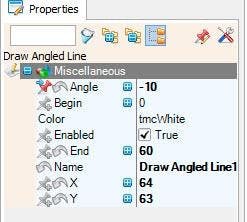
Analog Speed Or Volume Meter With Arduino
About the project
In this tutorial we will learn how to make a Volume or Speed analog meter using the OLED display and Arduino. Watch the Video
Project info
Difficulty: Easy
Estimated time: 1 hour
License: GNU General Public License, version 3 or later (GPL3+)
Items used in this project
Hardware components
Story
In this tutorial we will learn how to make a Volume or Speed analog meter using the OLED display and Arduino. This can be a great simple Indicator of any Analog source.Watch the Video!
Step 1: What You Will Need
1 / 5





- Arduino UNO or any other Arduino board
- Potentiometer
- OLED Display
- Jumper wires
- Breadboard
- Visuino software: Download here
Step 2: The Circuit

- Connect potentiometer pin [DTB] to arduino analog pin [A0]
- Connect potentiometer pin [VCC] to arduino pin [5V]
- Connect potentiometer pin [GND] to arduino pin [GND]
- Connect OLED display pin [VCC] to arduino pin [5V]
- Connect OLED display pin [GND] to arduino pin [GND]
- Connect OLED display pin [SDA] to arduino pin [SDA]
- Connect OLED display pin [SCL] to arduino pin [SCL]
Step 3: Start Visuino, and Select the Arduino UNO Board Type
1 / 2


The Visuino: https://www.visuino.eu also needs to be installed. Download Free version or register for a Free Trial.
Start Visuino as shown in the first picture Click on the "Tools" button on the Arduino component (Picture 1) in Visuino When the dialog appears, select "Arduino UNO" as shown on Picture 2
Step 4: In Visuino Add & Set Components
1 / 8








- Add "Multiply Analog By Value" component
In the properties window set Value to 100
- Add "Map Range Analog" component
In the properties window set Output Range Max to 0 and Output Range Min to -180
- Add "OLED display" component
- Double click on the DisplayOLED1 and in the Elements window:
- drag "Draw Angled Line" to the left side and in the properties window set Angle to -10, End to 60, X to 64, Y to 63, select angle and click on the pin icon and select Float Sink pin
- drag "Fill Screen" to the left side
- drag "Text Field" to the left side and in the properties window set X to 50 and Y to 50 drag "Draw Ellipse" to the left side and in the properties window set Height to 124, Width to 124 and Y to 20
- Close the Elements window
Step 5: In Visuino Add & Set Components
1 / 2


- First Connect Arduino Analog pin 0 to MapRange1 pin In
- Connect Arduino Analog pin 0 to MultiplyByValue1 pin In
- Connect MapRange1 pin Out to DisplayOLED1 Fill Screen1 pin Clock
- Connect MapRange1 pin Out to DisplayOLED1 Fill Draw Ellipse1 pin Clock Connect MapRange1 pin Out to DisplayOLED1 Draw Angled Line1 pin Angle Connect MapRange1 pin Out to DisplayOLED1 Draw Angled Line1 pin Clock
- Connect MultiplyByValue1 pin Out to DisplayOLED1 Text Field1 pin In
- Connect "DisplayOLED1" pin I2C Out to Arduino pin I2C In
Step 6: Generate, Compile, and Upload the Arduino Code

In Visuino, at the bottom click on the "Build" Tab, make sure the correct port is selected, then click on the "Compile/Build and Upload" button.
Step 7: Play
If you power the Arduino module and slide the potentiometer the display will start to show diferent positio.
Congratulations! You have completed your project with Visuino. Also attached is the Visuino project, that I created for this tutorial, you can download it and open it in Visuino: https://www.visuino.eu































